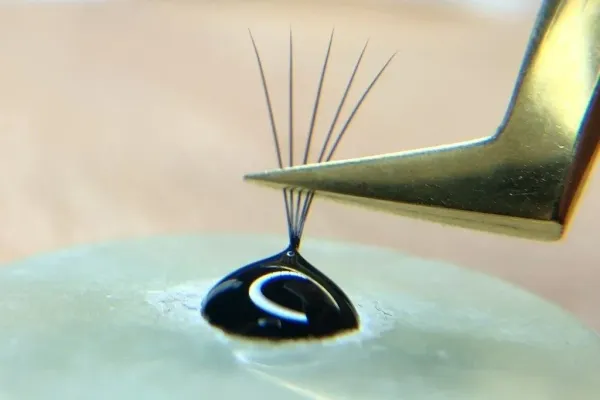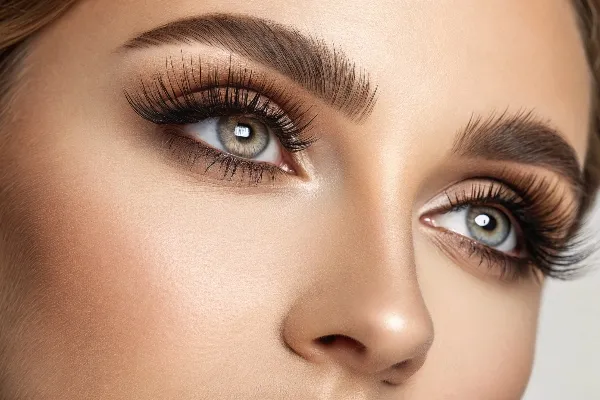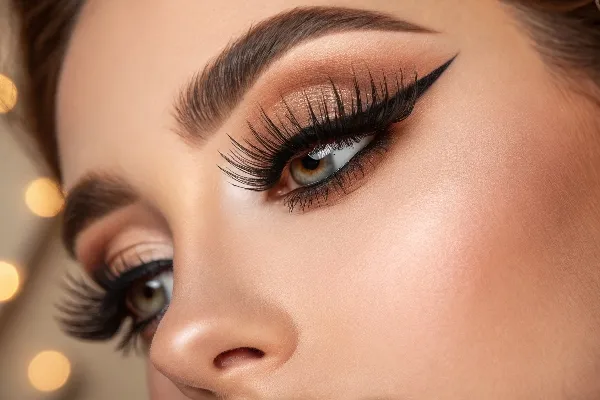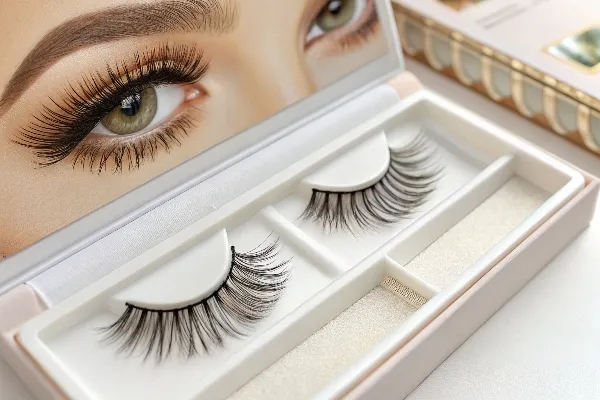Manchmal fühle ich mich unsicher, wenn ich in der Welt der Wimpern Begriffe wie "handgefertigte Fächer" oder "vorgefertigte Fächer" sehe. Ich frage mich, wie sehr diese Begriffe meinen endgültigen Look beeinflussen.
Handgefertigte Wimpern werden vor Ort von einem Wimpernkünstler angefertigt, während vorgefertigte Wimpern bereits aufgefächert und für die Anwendung vorbereitet sind. Dieser Unterschied wirkt sich auf die Individualisierung, die Kosten und die Dauer des Termins aus.

Wenn ich die Grundlagen von handgefertigten und vorgefertigten Wimpern kenne, kann ich entscheiden, welche Option für meinen Stil am besten geeignet ist. Lassen Sie uns nun einige wichtige Themen erörtern, die häufig aufkommen, wenn wir über falsche Wimpern, Verlängerungsdesigns und einfache Anwendung sprechen.
Manchmal fühle ich mich von der unendlichen Vielfalt an falschen Wimpern überwältigt. Ich weiß nicht, welches Material oder welcher Stil wirklich der beste ist.
Die beste Art von falschen Wimpern ist diejenige, die zu Ihrer Augenform, Ihrem Komfortbedarf und dem gewünschten Effekt passt. Zu den gängigen Favoriten gehören Kunstseide, Nerzimitat oder leichte Streifenwimpern.

Die Auswahl der besten falschen Wimpern kann verwirrend sein, wenn man nicht weiß, welche Faktoren am wichtigsten sind. Meiner Meinung nach sind drei Aspekte entscheidend: das Material, das Band und das Gesamtdesign. Materialien wie Kunstseide und Nerzimitat zeichnen sich dadurch aus, dass sie leicht und flexibel sind und einen realistischen Look bieten, ohne unangenehm zu sein. Synthetische Seidenwimpern haben oft einen sanften Glanz und fühlen sich weich an, während Nerzimitatwimpern in der Regel sehr leicht sind und einen subtilen Glanz haben.
Ein bequemes Wimpernband ist ebenso wichtig. Dünne Bänder aus Baumwolle oder durchsichtigen Materialien lassen sich oft leichter anbringen, da sie sich mit minimalem Aufwand an den Wimpernkranz anpassen. Dicke Bänder sind zwar formstabiler, lassen sich aber schwieriger verblenden und erfordern oft Eyeliner, um den Streifen zu verbergen. Wenn das Band zu starr ist, kann es sich an den Rändern abheben oder in den inneren Augenwinkel stoßen, was irritierend sein kann.
Mit verschiedenen Wimpernformen lassen sich unterschiedliche Effekte erzielen. Einige sind wuschelig und in der Länge gestaffelt, um echte Wimpern zu imitieren, andere sind gleichmäßig, um einen stärkeren Akzent zu setzen. Wenn ich einen natürlichen, alltäglichen Look haben möchte, wähle ich vielleicht einen Stil mit kürzeren Innenwinkeln und etwas längeren Außenwinkeln. Wenn ich auf einen dramatischen Look aus bin, ist eine dickere, gleichmäßigere Wimper mit mehr Länge vielleicht besser geeignet.
Es ist auch hilfreich, darauf zu achten, wie die Wimpern verpackt sind. Hochwertige Marken bieten oft eine Anleitung zum Zuschneiden der Wimpern, damit sie zu Ihrer Augenbreite passen. Ich messe den Streifen immer an meinem Wimpernkranz, bevor ich den Kleber auftrage, und schneide überschüssige Wimpern am äußeren Rand ab. Dieser kleine Schritt kann den Unterschied zwischen einer Wimper, die sich wie maßgeschneidert anfühlt, und einer, die ungünstig sitzt, ausmachen.
Auch der Preis und die Haltbarkeit spielen eine Rolle. Einige synthetische Wimpern sind zwar günstiger, können aber nach ein paar Mal Tragen ihre Form verlieren. Nerzimitat oder hochwertige Kunstseide können bei richtiger Reinigung und Aufbewahrung mehrmals verwendet werden. Kurz gesagt, die beste Art von künstlichen Wimpern passt zu Ihrem Komfort, zu Ihrer Augenform und zu dem von Ihnen gewünschten Look - ob minimalistisch oder dramatisch.
Mir ist aufgefallen, dass viele Wimpernkünstler Stile wie Cat-Eye, Doll-Eye oder Wispy-Sets auflisten. Ich bin neugierig, welches Design am gefragtesten ist.
Das beliebteste Wimpernverlängerungsdesign ist oft das Katzenauge, bei dem kürzere Wimpern in der inneren Ecke und längere Wimpern am äußeren Rand für einen schwülstigen, lüsternen Effekt sorgen.

In der Welt der Wimpernverlängerung sehe ich einige Stile, die sich häufig wiederholen: Katzenaugen, Puppenaugen, offene Augen und Wispern. Jeder Stil hat seinen eigenen Charme und wird durch das Anbringen von Verlängerungen bestimmter Längen in bestimmten Bereichen des Wimpernkranzes erreicht. Der Katzenaugen-Look wird häufig gewünscht, weil er die Augen verlängert und eine leicht exotische Form schafft. Sie schmeichelt vielen Augentypen, insbesondere runden Augen, die mandelförmiger erscheinen sollen.
Bei Puppenaugen oder offenen Augen werden längere Wimpern in der Mitte platziert, wodurch das Auge größer und runder wirkt. Dies ist perfekt für Augen, die tiefliegend oder mit Kapuze sind, da es die Mitte für einen hellen Blick öffnet. Bei Wispy-Sets werden Verlängerungen unterschiedlicher Länge am gesamten Wimpernkranz eingearbeitet, wodurch kleine Spitzen oder strukturierte Bereiche entstehen, die dem Auge mehr Dimension verleihen. Dieser Stil wird immer beliebter bei Kunden, die trendige, Instagram-taugliche Wimpern lieben.
Die Beliebtheit des Katzenauges beruht auch auf seiner Vielseitigkeit. Sie können dezent sein, indem Sie die Länge moderat halten, oder dramatisch, indem Sie die äußeren Ecken weit über Ihre natürlichen Wimpernspitzen hinaus verlängern. Ein erfahrener Wimpernkünstler kann den Winkel des Cat-Eye so anpassen, dass er mit Ihrem natürlichen Wimpernwachstum harmoniert. Das bedeutet kürzere Wimpern in der Nähe des inneren Winkels, die allmählich zu den längsten Wimpern in der Nähe des äußeren Winkels ansteigen.
Cat-Eye-Sets können mit klassischen, hybriden oder voluminösen Techniken ausgeführt werden. Für ein sanftes Cat-Eye reichen klassische Wimpern aus; für ein gewagteres Statement kann ein voluminöses Cat-Eye die Form wirklich betonen. Das Ergebnis ist eine geliftete, jugendliche Ästhetik, nach der sich viele Menschen sehnen. Auch wenn andere Designs wie Puppenaugen oder Wispern ebenfalls eine große Anhängerschaft haben, ist die Katzenaugenform nach wie vor die erste Wahl für Kunden, die sich eine schmeichelhafte, zeitlose Verlängerung wünschen.
Ich bevorzuge manchmal falsche Wimpern für besondere Anlässe, aber ich möchte nicht, dass sie unecht oder übertrieben aussehen. Ich bin neugierig, welche Modelle am besten mit echten Wimpern harmonieren.
Falsche Wimpern, die sich natürlich verjüngen, ein flexibles Band haben und in verschiedenen Längen erhältlich sind, sehen am natürlichsten aus. Nerzimitat oder leichte Seidenstreifen sorgen oft für ein nahtloses Finish.

Bei der Suche nach falschen Wimpern, die natürlich aussehen, achte ich auf mehrere Details. Erstens auf das Material: Nerzimitat oder leichte Seide bieten in der Regel eine weichere Textur mit einem sanften Glanz, der an echtes Haar erinnert. Von übermäßig glänzenden oder dicken Kunstfasern halte ich mich fern, da sie sich von meinen echten Wimpern abheben können. Zweitens ist die Form sehr wichtig. Ein Stil, der in der inneren Ecke kürzer beginnt und zum äußeren Rand hin allmählich länger wird, ahmt oft das normale Wachstum der Wimpern nach, anstatt eine einzige, einheitliche Länge über das gesamte Band zu haben.
Die Flexibilität des Bandes ist entscheidend für einen natürlichen Look. Ein flexibles, dünnes Band schmiegt sich eng an den Wimpernkranz an und verringert so Lücken, die die Falsies sichtbar machen könnten. Durchsichtige oder sehr dünne Baumwollbänder helfen mir auch dabei, einen dicken Strich zu vermeiden, der die falschen Wimpern sichtbar machen könnte. Wenn das Band zu dick ist, muss ich möglicherweise Eyeliner tragen, um den Wimpernansatz zu verbergen. Das ist zwar nicht unbedingt etwas Schlechtes, aber vielleicht nicht die beste Wahl, wenn ich einen frischen Look ohne Liner haben möchte.
Ich achte auch auf die Dichte der Wimpern. Ein Set mit moderatem Abstand zwischen den Fasern, das einige meiner natürlichen Wimpern durchscheinen lässt, wirkt oft glaubwürdiger. Zu dichte Streifen können auf Fotos wunderschön aussehen, im Alltag aber zu dick wirken. Einige Marken bezeichnen bestimmte Modelle als "natürlich" oder "leicht voluminös", daher prüfe ich diese Kategorien zuerst. Wenn ich die äußeren Ränder genau an meine Augenform anpasse, können sie nach dem Aufkleben noch realistischer wirken.
Ein weiterer Trick besteht darin, meine echten Wimpern mit den Falsies zu vermischen, indem ich nach dem Auftragen nur wenig Mascara verwende. Eine leichte Schicht am unteren Ende der beiden Wimpernsets hilft, sie zu vereinen. Ich achte auch darauf, die Wimpern zu reinigen und neu zu tuschen. Reste von Klebstoff oder alte Mascaraklumpen können das nahtlose Finish ruinieren. Wenn ich leichtere, gut verjüngte Wimpern wähle und mir ein wenig Zeit nehme, um die Passform anzupassen, erhalte ich einen so natürlichen Look, dass sich die Leute oft fragen, ob ich einfach mit perfekten Wimpern geboren wurde.
Ich erinnere mich, dass ich mit Wimpernstreifen zu kämpfen hatte, die sich nicht richtig bogen oder an den Rändern absprangen. Wenn ich mit falschen Wimpern neu anfange, möchte ich etwas Einfaches.
Anfängerfreundliche Wimpern haben in der Regel ein dünnes, flexibles Band und eine kürzere Länge, wodurch sie leichter zu positionieren sind. Halbwimpern oder akzentuierte Wimpern können die einfachste Wahl sein.

Das Anbringen falscher Wimpern kann entmutigend sein, vor allem, wenn das Band steif ist oder der Stil sehr groß ist. Ich glaube, die einfachste Methode für Neulinge besteht darin, mit Halbwimpern oder Akzentwimpern zu beginnen. Diese sind so konzipiert, dass sie nur den äußeren Teil des Wimpernkranzes bedecken und den heiklen inneren Wimpernwinkel vermeiden, der zu einem Lifting führen kann. Halbe Wimpern sorgen für einen leichten Schwung und Volumen an den äußeren Rändern und verstärken die Form, ohne dass sie perfekt am gesamten Wimpernkranz platziert werden müssen.
Ein weiteres anfängerfreundliches Modell ist ein durchsichtiges, flexibles Band, das ohne großen Kraftaufwand haftet. Einige Marken bieten sogar vorgeklebte oder selbstklebende Wimpern an, die allerdings nicht so lange halten wie Wimpern, die geklebt werden müssen. Wenn ich Kleber verwende, suche ich nach einer Formel mit einem Pinselapplikator und nicht nach einer Tube. So habe ich eine bessere Kontrolle und kann nicht zu viel Kleber auftragen, was zu einer unordentlichen Anwendung führen kann.
Ich habe auch die Erfahrung gemacht, dass die Wahl leichterer, kürzerer Wimpernstreifen das Risiko verringert, dass sie aufplatzen. Schwere oder extralange Wimpern erfordern mehr Präzision und können sich unangenehm anfühlen, wenn Sie nicht an das Tragen von Falsies gewöhnt sind. Eine Länge, die nur geringfügig länger als Ihre natürlichen Wimpern ist, kann verzeihen, wenn Sie sie nicht perfekt ausrichten.
Um Vertrauen zu gewinnen, übe ich manchmal die Positionierung der Wimpern, bevor ich den Kleber auftrage. Ich lege den Streifen auf meinen Wimpernkranz, um zu sehen, wo ich eventuell nachschneiden muss. Bei den meisten Menschen ist der Wimpernkranz nicht so breit wie der durchschnittliche Streifen, so dass das Entfernen eines kleinen Abschnitts aus der äußeren Ecke in der Regel den Sitz und den Komfort verbessert. Wenn ich nach dem Auftragen des Klebers etwa 30 Sekunden warte, bis er klebrig geworden ist, kann ich sicherstellen, dass die Wimpern an Ort und Stelle bleiben, wenn ich sie auf mein Lid drücke. Eine Pinzette oder ein Wimpernapplikator helfen mir, einen präzisen Halt zu finden.
Im Folgenden finden Sie eine Kurzanleitung für einfache Einsteigeroptionen:
| Wimpern Typ | Hauptmerkmal | Warum es für Einsteiger einfach ist |
|---|---|---|
| Halbwimpern | Deckt nur die äußere Hälfte ab | Vermeidet heikle Innenecken |
| Akzentwimpern | Verleiht bestimmten Bereichen mehr Volumen | Begrenzte Platzierung erforderlich |
| Dünne Bänder | Flexibel, leicht | Passt sich dem Wimpernkranz an |
| Vorgeklebt | Inklusive Klebestreifen | Überspringt den separaten Klebeschritt |
Wenn Sie diese Tipps befolgen, kann der Prozess reibungsloser verlaufen. Durch die Auswahl eines leichten Stils und die Konzentration auf eine einfachere Anbringungsmethode gewinnen Anfänger schnell Vertrauen. Mit der Zeit kann ich mich dann an volle Streifen, magnetische Wimpern oder aufwändigere Stile heranwagen.
Handgefertigte Wimpern ermöglichen es Künstlern, jeden Fächer individuell zu gestalten, während vorgefertigte Wimpern Schnelligkeit und Konsistenz bieten. Ob Sie den natürlichsten Stil, das trendigste Design oder die einfachste Anwendung wünschen, die Wahl der richtigen Wimpernart hängt von Ihren Vorlieben und Ihrem Komfort ab. Indem Sie verschiedene Optionen ausprobieren, können Sie herausfinden, welcher Ansatz und welche Materialien am besten zu Ihrer täglichen Routine oder Ihrem Stil für besondere Anlässe passen.